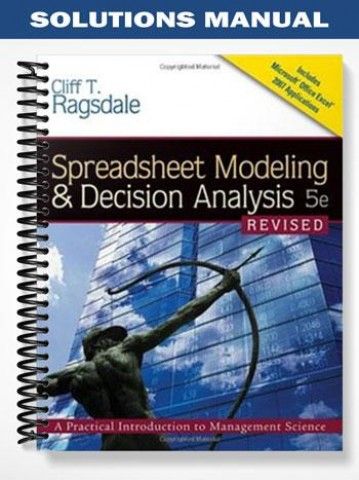Solution Manual for Spreadsheet Modeling and Decision Analysis 8th Edition by Ragsdale
Chapter 1
Introduction to Modeling & Problem Solving
- Solution Manual for Spreadsheet Modeling and Decision Analysis Decision Analysis – Identifying and evaluating the different possible courses of action that might be chosen to address a decision problem.
- Solution Manual for Spreadsheet Modeling and Decision Analysis Computer Model – A set of mathematical relationships and logical assumptions implemented in a computer as a representation of some real-world object or phenomenon.
- A spreadsheet model is a type (or special case) of a computer model where a spreadsheet is used to implement the model.
- Solution Manual for Spreadsheet Modeling and Decision Analysis Business Analytics – A field of study that uses computers, statistics and mathematics to solve business problems.
- Many of the tools and techniques from the field of business analytics can be implemented and used in spreadsheets.
- Solution Manual for Spreadsheet Modeling and Decision Analysis Spreadsheets are sometimes used to store lists of data; such as the grades of students in a class, or names addresses and phone numbers of friends and family. These types of “data base” applications of spreadsheets do not fall into the area of business analytics unless they data is being “mined” with a specific objective in mind.
- Spreadsheets facilitate the decision-making process by making it easier to play out various what-if scenarios.
- A modeling approach to decision making is beneficial in that the decision maker can analyze the probable impact of numerous alternative before selecting an alternative for implementation.
- Dependent Variable – A bottom-line performance measure of interest to the decision maker that is influenced by other variables in the model; denoted by the symbol Y in the expression Y=(X1, X2, … X3).
- Solution Manual for Spreadsheet Modeling and Decision Analysis Independent Variable – A variable that influences (or plays a role in determining) the value of some bottom-line performance measure (dependent variable); denoted by the symbols Xiin the expression Y=(X1, X2, … X3).
- Yes, a model can have more than one dependent variable. In some decision problems a manager might be interested in evaluating various alternatives on the basis of profit, probable number of injuries, resulting amount of toxic waste produced, etc. Each of the variables represents a bottom-line performance measure that the manager might be interested in that should be included in the model.
- Yes. See the answer to the previous question.
- The solution to prescriptive models tell managers what actions to take while descriptive models simply describe the operation of a system. In descriptive models, the values to be assumed by one or more independent variables are uncertain and not under the decision maker’s control.
- The solution to prescriptive models tell managers what actions to take while predictive models provide forecasts of what will happen in the future. In predictive models, the functional form () describing the nature of the relationship between the dependent and independent variable is ill-defined or not precisely known.
- Descriptive models have a well-defined functional form, but the values of one or more of the independent variables are unknown or uncertain. In predictive models, the values of the independent variables are known or under the decision maker’s control, but the functional form () describing the nature of the relationship between the dependent and independent variables is ill-defined or not precisely known.
- Description – To report on or summarize the features, characteristics or behavior of some object or phenomenon.
Prediction – An estimate or forecast of what will occur in the future.
Prescription – Directions, orders, or advise on how to solve a problem.
- Consider the problem of determining how to travel from your home to school or work. There are probably many different routes that could be taken that might influence the total distance (or total length of time) required for the trip. Most people would be interested in determining the route that requires the least distance (or least amount of time). In this sort of problem (also known as a shortest path problem) the different routes that can be chosen represent independent variables and the dependent variable would be the total distance (or total travel time).
- The spreadsheet in Figure 1.2 most closely resembles a prescriptive model because the function form () relating the dependent and independent variables is well-defined and the values of the independent variables are known, or are under the decision maker’s control.
- “Probortunity” is the combination of the words problem and opportunity and denotes the fact that every problem can also be viewed as an opportunity.
- The steps in the problem solving process are:
1) Identify the problem
2) Formulate and implement a model
3) Analyze the model
4) Test the result of the model
5) Implement the solution











